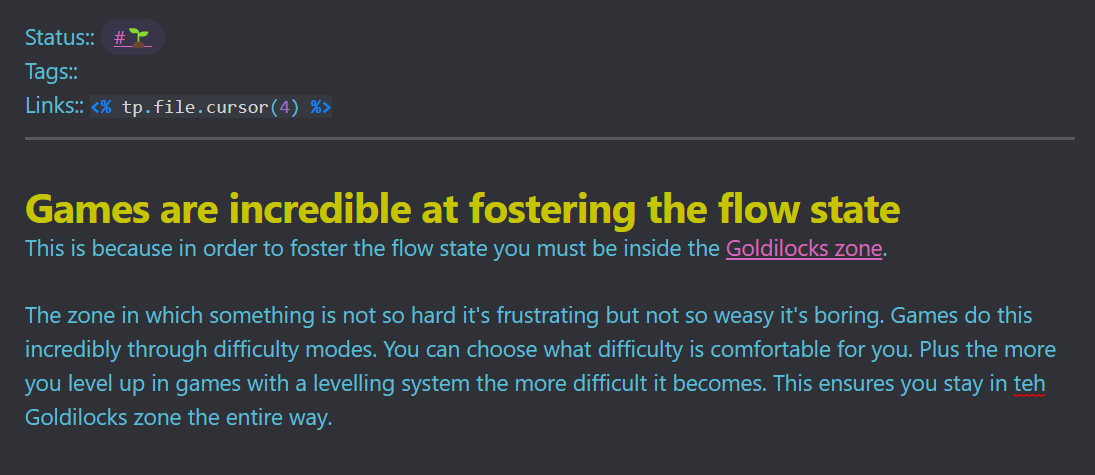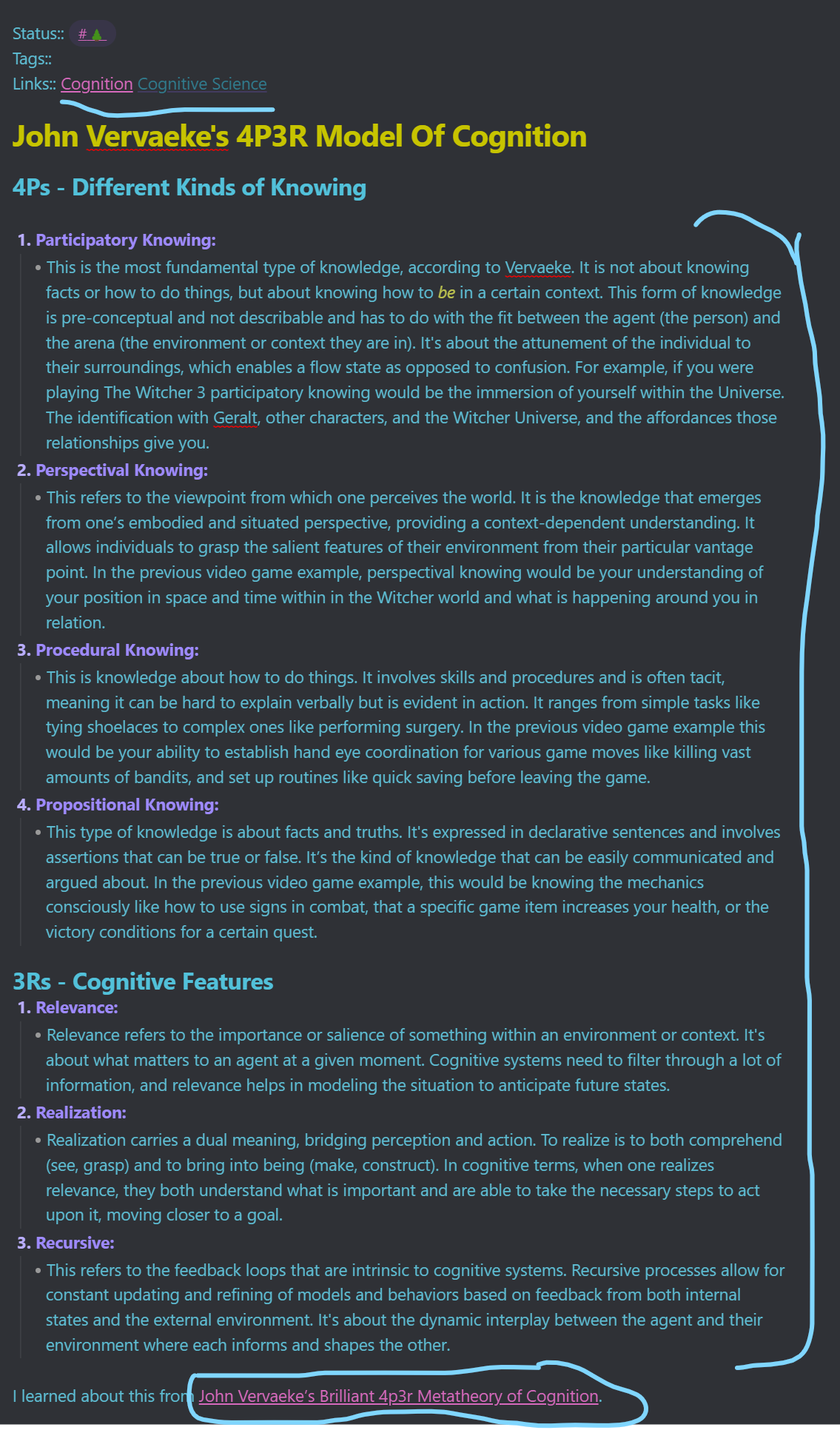🔗Lesson 2: How To Create Novel Insights With Linked Book Notes
Today's Challenge: Practice Creating Linked Book Notes
Hello !
Yesterday you learned why you should learn to take linked book notes. Today you will learn the 3 step process for creating novel insights with linked book notes.
Before you can create linked book notes, you need to get your book highlights into your notetaking app. If you already know how to do that, you can go to the next step. However, if you don't, here's a super quick article from me you can read to do so.
Once you have whatever highlights you have from the book you chose from yesterday you can move onto the 3-step process!
3 Step Process For Creating Linked Book Notes
It's finally time!
You have your highlights in your notetaking app or your physical book in front of you and are ready to create linked book notes. I usually create linked book notes in the few days to weeks after finishing a book while it's still fresh in my mind. When I'm ready, I go into my book note and put this book summary template at the top (the code is in markdown so convert it if you need for your notetaking software):
🚀The Book in 3 Sentences
🎨 Impressions
📖Who Should Read It?
☘️ How the Book Changed Me
✍️ My Top 3 Quotes
Linked Book Notes
Then, I follow these three steps for creating my linked book notes.
- Step 1: Read Through Your Highlights And Annotations
- Step 2: Create Linked Book Notes With Freewriting, RRR, And The Idea Compass
- Step 3: Fill Out The Book Summary Template
Let's go through each of those steps!
Step 1: Read Through Your Highlights And Annotations
Firstly, I read through all of my highlights and annotations.
This helps me recontextualize myself with the book and primes me for creating my linked book notes.
Step 2: Create Linked Book Notes With Freewriting, RRR, And The Idea Compass
In step 2, I start creating linked book notes by returning to the top of my highlights and reading down, creating linked book notes along the way.
I like to have two tabs open in my notetaking app while I do this; one on the left where I read through the book highlights and one on the right where I create the linked book notes.
I write my linked book notes underneath the linked book notes header and often include the chapter heading from which the linked book note was created so I know what chapter it was from.
The Three Principles Of Linked Book Notes
When creating my linked book notes, I follow 3 principles:
- Atomicity
- Write In Your Own Words
- Write Your Book Notes As Propositions or Arguments
Firstly, the principle of atomicity states one idea forms the emphasis of the note, and the other ideas are background contextual or supporting evidence.
This means they can be quite large and have many ideas, BUT they FOCUS on one. Think of some of your book notes like a small hydrogen atom and others like a big Uranium atom. The reason I create notes that focus on one idea is it allows me to link them to other notes seamlessly. If the note has too much information inside, linking is useless because it's too big to form an interesting insight.
Secondly, write your linked book notes in your own words.
They can have quotes and supporting evidence inside, but they should have your own interpretation. This ensures you actively engage with your book. In addition, adopt the mindset that your notes are pieces of understanding rather than pieces of truth. Your notes don't have to be the divine mandates of heaven. They can include half-baked thoughts and ideas. You can always come back and grow them over time.
Thirdly, I like to write the titles of my linked book notes as propositions or arguments.
Then, inside of the note itself, I expand on the proposition or argument I'm making. Titling notes like this makes them easier to link inside other notes later on and ensures they fit grammatically. I don't want any Grammar Nazis coming for me.
IMPORTANT: Not everything should be made into a linked book note. Don't make the creation of linked book notes into a method of procrastination. Linked book notes should be made only for things that aren't USE, unimportant, self-explanatory, and easy enough to explain on the spot.
Now that you know my principles for creating linked notes, let me show you the three methods I use for doing so: freewriting, RRR, and The Idea Compass.
Freewriting
Freewriting involves opening up a new note or existing note and letting your thoughts flow.
There is no judgment. You freely write.
After some time, 30 seconds, two minutes, or five hours--I'm just joking--you go back through your freewriting and create new notes out of the gold nuggets. You might take some of the surrounding text into this new note and start the whole freewriting process over again. Freewriting is probably the most common method of creating linked book notes as it's the most versatile.
Writing your thoughts down freely helps you overcome the perfectionist judgment so many people have.
For example, while taking linked book notes on A Theory Of Fun For Game Design by Raph Koster I created a note called "games are incredible at fostering the flow state" and did 2 minutes of freewriting below.


Notice how there are misspellings in the text. I was just writing my thoughts out no judgement.
Now I can go through and create new notes out of ideas inside the freewriting.
RRR
RRR stands for remark, relate, reference.
It's a method I first encountered from Nick Milo in his Linking Your Thinking Workshop. Essentially, whenever you create a linked book note, you make a remark, relate it to another note, and then you reference the resource you got the idea from, in this case, your book. You can also start with the resource by including a direct quote from the book and then making a remark and relating.
There are no RULES!
This is where your work highlighting and annotating shows itself.
If you did a good job highlighting and annotating, you will be left with the core essence of the book and not have a ton of work to do creating your linked book notes. If your past self was really nice, they might have included ideas for what to connect in your linked book notes inside of the annotations.
Here's an example of RRR using a note I created from consuming the lecture series Awakening From The Meaning Crisis by John Vervaeke.

You can see I have marked out each of the relevant sections of RRR in the note above.
The Idea Compass
I first heard about the idea compass from Vicky Zhao and Fei Ling Tseng on a Linking Your Thinking Workshop video.
Essentially, it works by asking yourself one of the four main questions below or sub-questions to think about connecting a note. All the questions are framed around the analogy of a compass. If you were a Boy Scout like me, you will appreciate this:

I like the compass metaphor for notetaking because it helps you think about the effects of an idea in a whole bunch of different directions.Once you finish reading through all of your highlights and creating your linked book notes, you should have a pretty assemblage of notes under your linked book notes header.
Here's an example of me using the Idea Compass in my note on Hedonic Adaptation:

Step 3: Fill Out The Book Summary Template
Now, it's time to fill out the book summary template.
Simply write out a summary of the book in 3 sentences. This is more for your future self than anything in case they want to recontextualize themselves with the book.
Write out your impressions. How did you think and feel about the book? If you didn't like something, BASH IT IN, lol. Or be nice.
Who else should read the book? This will give you ideas for people you might consider gifting the book to.
How did the book change you? Do you see the world any differently now? Did you apply or want to apply anything from the book?
Finally, what were your top 3 quotes?
The End Result Of Linked Book Notetaking
The end result of my linked book notetaking is a filled out book summary, and a number of linked book notes. Each of these book notes is linked to other books and other notes in my system. Isn't it beautiful? This is the foundation of my lego brick insight empire.
Summary Of The Linked Book Notes Process
The linked book note-taking process is a method to deeply engage with and synthesize information from a book, transforming reading into a more active form of learning.
Here's a concise summary of the process:
Step 1: Review Your Highlights and Annotations
Carefully read through all your highlights and annotations from the Kindle app to re-familiarize yourself with the key points and ideas of the book.
Step 2: Create Linked Book Notes
Use two-panel note-taking to organize your process. On one side, read your book highlights, and on the other, begin writing linked book notes, adhering to three main principles:
- Atomicity: Each note focuses on one main idea, supported by relevant context and details, ensuring clarity and ease of linking with other notes.
- Original Wording: Paraphrase the ideas using your own language, encouraging active processing and better understanding.
- Propositional And Argumentative Titles: Frame note titles as propositions or arguments to clearly state the idea, then elaborate within the note itself.
Avoid turning every piece of information into a linked note; focus on significant, non-obvious, and complex ideas that truly add value to your understanding.
In creating these notes, apply three methods:
- Freewriting: Let your thoughts flow without judgment, then distill new insights into separate notes.
- RRR (Remark, Relate, Reference): Comment on the idea, connect it to other notes or concepts, and cite the source, often starting with quotes from the book.
- The Idea Compass: Ask directional questions (North, South, East, West) to explore different dimensions and connections of an idea.
Step 3: Fill Out The Book Summary Template
Fill out the book summary template.
This process turns passive reading into an active learning exercise, ensuring that you not only remember the content better but also develop a web of knowledge you can apply in various contexts.
🎯Take Action Today
- Practice creating linked book notes using the book you chose from yesterday. You can do this EVEN if you haven't finished the book yet. And you don't have to create linked book notes out of the entire book--unless you want to. For the purpose of this lesson, you just need to create one linked book note using Freewriting, one using RRR, and one using The Idea Compass.
- P.S. If you want a video example of me creating linked book notes to serve as accountability or get clarity, you can watch it here
- P.S.S. I also have a workshop recording of me going through this linked book notetaking process you can watch here if you want more clarity or accountability
🎊Congrats you completed your second-day action items for the course!🎊
Tomorrow, you will learn how to compound your knowledge using Maps Of Content.
If you want to do tomorrow's lesson NOW (look at you go with that energy!) you can do so here: https://www.aidanhelfant.com/lesson-3-how-to-compound-your-knowledge-with-maps-of-content/
